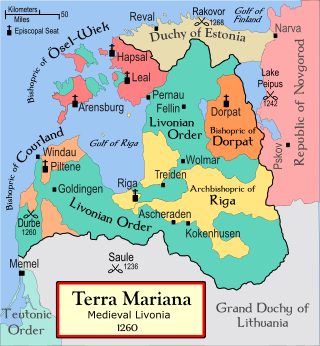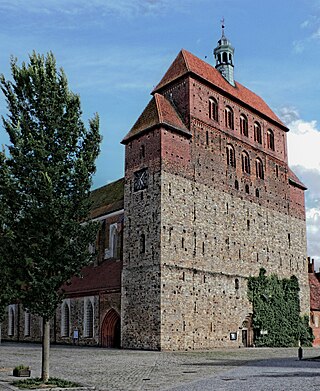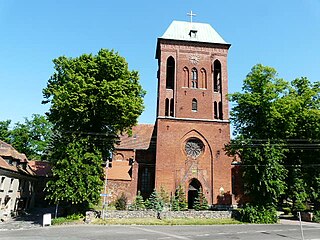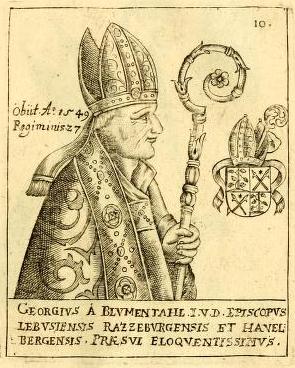
The Archbishopric of Magdeburg was a Latin Catholic archdiocese (969–1552) and Prince-Archbishopric (1180–1680) of the Holy Roman Empire centered on the city of Magdeburg on the Elbe River.

The Bishopric of Ösel–Wiek was a Roman Catholic diocese and a semi-independent prince-bishopric — part of Terra Mariana in the Holy Roman Empire. The bishopric covered what are now Saare, Hiiu, Lääne counties and the western part of Pärnu county of Estonia.

The Bishopric of Dorpat was a medieval prince-bishopric, i.e. both a diocese of the Roman Catholic Church and a temporal principality ruled by the bishop of the diocese. It existed from 1224 to 1558, generally encompassing the area that now comprises Tartu County, Põlva County, Võru County, and Jõgeva County in Estonia. The prince-bishopric was a sovereign member of the Holy Roman Empire and part of the Livonian Confederation until its dissolution in 1561.

The diocese of Brandenburg existed between the 10th and 16th centuries. From the 12th century, its bishops also ruled the Hochstift Brandenburg.

The Diocese of Lebus is a former diocese of the Catholic Church. It was erected in 1125 and suppressed in 1598. The Bishop of Lebus was also, ex officio, the ruler of a lordship that was coextensive with the territory of the diocese. The geographic remit included areas that are today part of the land of Brandenburg in Germany and the Province of Lubusz in Poland. It included areas on both sides of the Oder River around the town of Lebus. The cathedral was built on the castle hill in Lubusz and was dedicated to St Adalbert of Prague. Later, the seat moved to Górzyca, back to Lebus and finally to Fürstenwalde on the River Spree.

The Prince-Bishopric of Minden was an ecclesiastical principality of the Holy Roman Empire. It was progressively secularized following the Protestant Reformation when it came under the rule of Protestant rulers, and by the Peace of Westphalia of 1648 given to Brandenburg as the Principality of Minden. It must not be confused with the Roman Catholic diocese of Minden, which was larger, and over which the prince-bishop exercised spiritual authority.

The Bishopric of Havelberg was a Roman Catholic diocese founded by King Otto I of Germany in 946, from 968 a suffragan to the Archbishops of Magedeburg. A Prince-bishopric (Hochstift) from 1151, Havelberg as a result of the Protestant Reformation was secularised and finally annexed by the margraves of Brandenburg in 1598.

The Bishopric of Cammin was both a former Roman Catholic diocese in the Duchy of Pomerania from 1140 to 1544, and a secular territory of the Holy Roman Empire (Prince-Bishopric) in the Kołobrzeg area from 1248 to 1650.

The Prince-Bishopric of Paderborn was an ecclesiastical principality (Hochstift) of the Holy Roman Empire from 1281 to 1802.

Georg von Blumenthal was a German Prince-Bishop of Ratzeburg and Bishop of Lebus. He also served as a Privy Councillor of the Margraviate of Brandenburg and Chancellor of the University of Frankfurt (Oder), commonly called the Viadrina.

In the Holy Roman Empire, the German term Hochstift referred to the territory ruled by a bishop as a prince, as opposed to his diocese, generally much larger and over which he exercised only spiritual authority. The terms prince-bishopric and ecclesiastical principality are synonymous with Hochstift. Erzstift and Kurerzstift referred respectively to the territory (prince-archbishopric) ruled by a prince-archbishop and an elector-archbishop while Stift referred to the territory ruled by an imperial abbot or abbess, or a princely abbot or abbess. Stift was also often used to refer to any type of ecclesiastical principality.

Joachim of Münsterberg, also: Joachim of Poděbrady, a member of the Podiebrad family, was Silesian duke of Münsterberg and Oels from 1536 to 1542. He also held the title of a Count of Kladsko (Kłodzko), though he never actually ruled the county. From 1545 to 1560 he was Prince-Bishop of Brandenburg.

Matthias von Jagow was a Bishop of Brandenburg and reformer in Brandenburg.

The Prince-Bishopric of Chur was an ecclesiastical principality of the Holy Roman Empire, and had Imperial immediacy. The Prince-Bishopric of Chur controlled contiguous land from the city of Chur, to Engadin, and to Vinschgau. The historical State must be distinguished from the Roman Catholic Diocese of Chur which still exists, even if the bishop was the same man.
The 13 Cuirassier regiments of Old Prussia were formed in the mid-17th to mid-18th centuries, and formed the basis of Frederick the Great's vaunted cavalry.
Dietrich von Hardenberg was bishop of the Diocese of Brandenburg from 1521 to 1526.


![Ziesar Castle [de], now a museum also showing the history of the Prince-Bishopric of Brandenburg Burg Ziesar 14.jpg](http://upload.wikimedia.org/wikipedia/commons/thumb/6/6d/Burg_Ziesar_14.jpg/220px-Burg_Ziesar_14.jpg)












